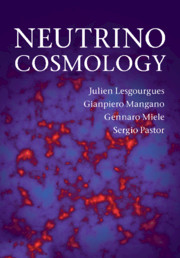Book contents
- Frontmatter
- Contents
- Preface
- 1 The basics of neutrino physics
- 2 Overview of the Standard Cosmological Model
- 3 Neutrinos in the early ages
- 4 Neutrinos in the MeV age
- 5 Neutrinos in the cosmic microwave background epoch
- 6 Recent times: neutrinos and structure formation
- 7 Cosmological neutrinos today
- References
- Index
7 - Cosmological neutrinos today
Published online by Cambridge University Press: 05 March 2013
- Frontmatter
- Contents
- Preface
- 1 The basics of neutrino physics
- 2 Overview of the Standard Cosmological Model
- 3 Neutrinos in the early ages
- 4 Neutrinos in the MeV age
- 5 Neutrinos in the cosmic microwave background epoch
- 6 Recent times: neutrinos and structure formation
- 7 Cosmological neutrinos today
- References
- Index
Summary
Our journey in the land of neutrino cosmology is almost over. We have seen how neutrinos have silently influenced the evolution of the universe: how they perhaps may be responsible for the production of the baryon density we observe today, and the way they leave their signature in the nuclear abundances during primordial nucleosynthesis, in the CMB anisotropies and in structure formation.
We cannot leave the patient reader, who has kindly followed us till this point, without offering some final considerations about a simple question he or she might have thought about since the very beginning: can we directly detect the neutrino background in a laboratory experiment as Penzias and Wilson did for the CMB radiation?
There are two major obstacles one must overcome to achieve such a goal. Neutrinos are elusive particles because they interact only weakly. Cross sections are typically small, far smaller than electromagnetic ones, which were exploited by Penzias and Wilson. Furthermore, relic neutrinos today are quite cold particles with an average momentum on the order of c pν ~ 3.15 Tν,0 ~ 5 × 10−4 eV, so reaction rates are further suppressed. For the best interaction process candidate to date, neutrino capture on β-unstable nuclei such as 3H, we have 〈σν/c〈 ~ 10−44 cm2.
- Type
- Chapter
- Information
- Neutrino Cosmology , pp. 348 - 361Publisher: Cambridge University PressPrint publication year: 2013



